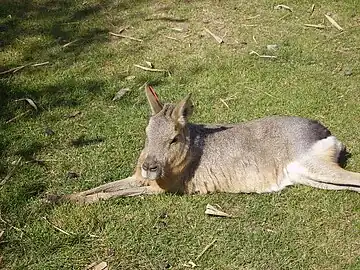| Dolichotinae Temporal range: Montehermosan-Recent ~ | |
|---|---|
 | |
| Patagonian mara (Dolichotis patagonum) | |
| Scientific classification | |
| Domain: | Eukaryota |
| Kingdom: | Animalia |
| Phylum: | Chordata |
| Class: | Mammalia |
| Order: | Rodentia |
| Family: | Caviidae |
| Subfamily: | Dolichotinae |
| Genera | |
|
See text | |
 | |
| Approximate range of the extant maras | |
Maras, subfamily Dolichotinae, are a group of rodents in the family Caviidae.[1] These large relatives of guinea pigs are common in the Patagonian steppes of Argentina, but also live in Paraguay and elsewhere in South America. There are two extant species, the Patagonian mara of the genus Dolichotis and the Chacoan mara of the genus Pediolagus. Traditionally this species was also thought to belong to Dolichotis; however, a 2020 study by the American Society of Mammalogists found significant difference between the two mara species to warrant resurrecting the genus Pediolagus for it.[2] Several extinct genera are also known.[3]
Description
Maras have stocky bodies, three sharp-clawed digits on the hind feet, and four digits of the fore feet. Maras have been described as resembling long-legged rabbits; while standing, they can also resemble a small ungulate. Patagonian maras can run at speeds up to 29 km/h (18 mph). The Patagonian species can weigh over 11 kg (24 lb) in adulthood. The average weight of adult male Patagonian maras is 8.3 kg (18 lb) and in adult females is 7.75 kg (17.1 lb).[4] Meanwhile, the Chacoan mara, though still large for a rodent, is much smaller, weighing around 1 to 3 kg (2.2 to 6.6 lb).[5]
Most maras have brown heads and bodies, dark (almost black) rumps with a white fringe around the base, and white bellies.
Maras may amble, hop in a rabbit-like fashion, gallop, or bounce on all fours. They have been known to leap up to 6 ft (1.8 m).
Maras mate for life, and may have from one to three offspring each year. Mara young are very well-developed, and can start grazing within 24 hours. They use a crèche system, where one pair of adults keeps watch all the young in the crèche. If they spot danger, the young rush below ground into a burrow, and the adults are left to run to escape.[4]
Genera
- Dolichotis
- Pediolagus
- †Eodolichotis
- †Pliodolichotis
- †Propediolagus
- †Rhodanodolichotis
Interaction with humans
Patagonian maras are often kept in zoos or as pets, and are also known as "Patagonian cavies" or "Patagonian hares". They can be quite social with humans if raised with human interaction from a young age, though they avoid people in the wild. Maras may even change their habits from coming out in day to becoming nocturnal, simply to avoid social interaction. In 2021 they had young in Leningrad Zoo of Saint Petersburg, Russia.[6]
Gallery
 Patagonian mara at the Wildlife Ranch in San Antonio, Texas
Patagonian mara at the Wildlife Ranch in San Antonio, Texas A pair of Patagonian maras at the Melbourne Zoo
A pair of Patagonian maras at the Melbourne Zoo Close-up of a Patagonian mara
Close-up of a Patagonian mara Mara at Tropical Wings
Mara at Tropical Wings
References
- ↑ Woods, C.A.; Kilpatrick, C.W. (2005). "Infraorder Hystricognathi". In Wilson, D.E.; Reeder, D.M (eds.). Mammal Species of the World: A Taxonomic and Geographic Reference (3rd ed.). Johns Hopkins University Press. p. 1555. ISBN 978-0-8018-8221-0. OCLC 62265494.
- ↑ Campo, D.H. (2020). "Integrative taxonomy of extant maras supports the recognition of the genera Pediolagus and Dolichotis within the Dolichotinae (Rodentia, Caviidae)". Journal of Mammalogy. 101 (3): 817–834. doi:10.1093/jmammal/gyaa038.
- ↑ "Dolichotinae". Fossilworks.
- 1 2 Campos, C. M., Tognelli, M. F., & Ojeda, R. A. (2001). Dolichotis patagonum. Mammalian species, 2001(652), 1-5.
- ↑ Campo, D. H., Caraballo, D. A., Cassini, G. H., Lucero, S. O., & Teta, P. (2020). Integrative taxonomy of extant maras supports the recognition of the genera Pediolagus and Dolichotis within the Dolichotinae (Rodentia, Caviidae). Journal of Mammalogy, 101(3), 817-834.
- ↑ "В Ленинградском зоопарке родились патагонские мары". spbdnevnik.ru (in Russian). Retrieved 2021-10-21.